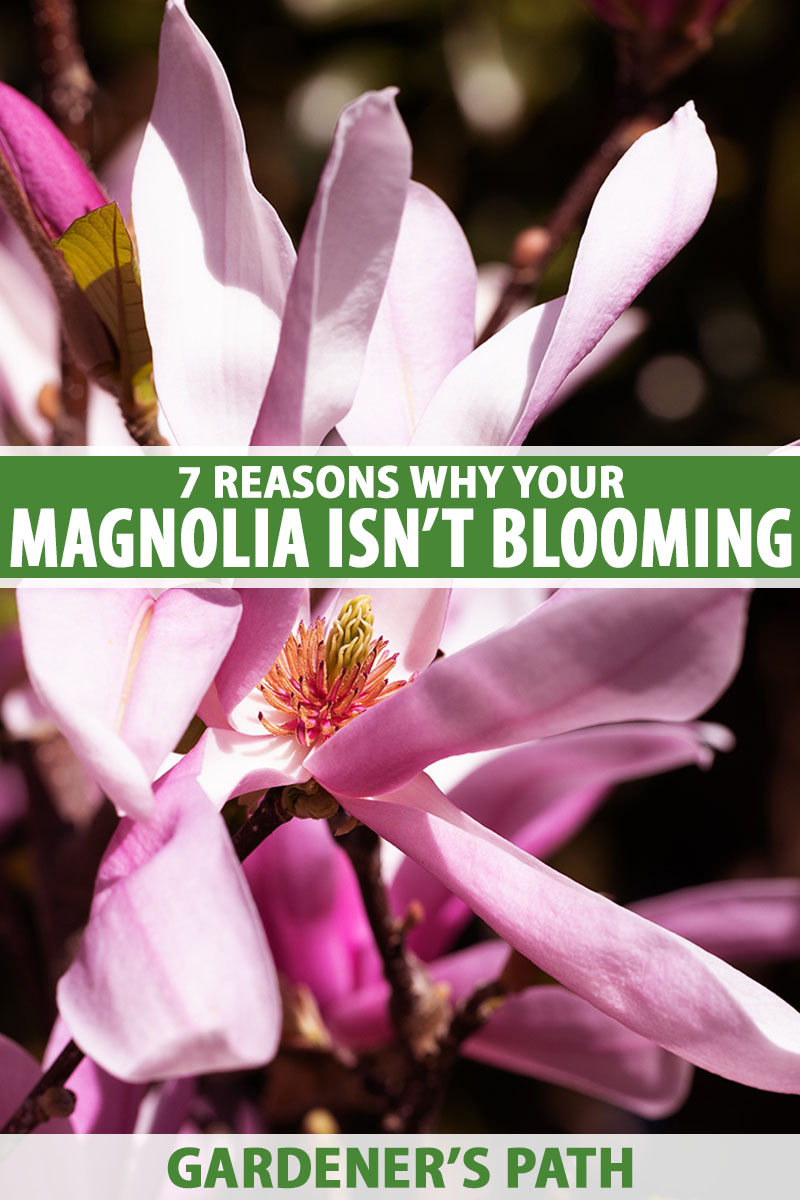When magnolias are not in bloom, the large leathery leaves provide interest, especially those with multicolored foliage.
The shape is charming, whether you pick a petite saucer with its umbrella-like crown, or a rare columnar type.
But let’s not mince words, it’s the flowers we really love. Even when they only appear for a week or two, their bloom season cut short by a late freeze, we grow these trees for their blossoms.

We link to vendors to help you find relevant products. If you buy from one of our links, we may earn a commission.
So if a magnolia fails to bloom, it’s pretty devastating.
Sometimes, it’s just bad luck, but other times the cause is preventable.
In our guide to growing magnolias, we discuss how to cultivate these trees in the landscape.
This guide is all about the reasons why a magnolia tree may not flower, what you can do about it, if anything, and how to prevent it in the future.
Here are the seven common causes we’ll talk about:
Most magnolias bloom in early spring, but others, like lily (M. lilliflora), M. x loebneri hybrids, and star (M. stellata) magnolias will bloom a second or even third time in the spring or summer. This round is usually smaller than the first one, with fewer flowers.
If a reblooming type doesn’t produce a second flush one year, don’t worry. It’s a sign that the tree may have been stressed for some reason, such as an unusually hot or dry spring. If the next year is better, the tree should rebloom as usual.
Trees that fail to bloom at all are a different matter.
The first common cause we’ll talk about is pretty straightforward and the cure is patience:
1. Age
Flowers are the plant’s method of reproduction, and as with humans, the plant isn’t ready to reproduce until it reaches maturity.
The age that the plant reaches maturity will depend entirely on the particular species, hybrid, or cultivar you are growing.

Some, like saucer magnolias (M. x soulangeana), start young. It’s not unusual to see them blooming when they’re just three years old.
A southern magnolia (M. grandiflora), on the other hand, needs a decade or longer to get started.
Here are a few common species and the approximate age that you can expect them to bloom. Remember that this can vary a little depending on the specific cultivar.
- Star (M. stellata): 2-3 years
- Bigleaf (M. macrophylla) 12-15 years
- Saucer (M. x soulangeana) 3-5 years
- Southern (M. grandiflora) 10-13 years
- Cucumber (M. acuminata) 12-15 years
- Sweetbay (M. virginiana) 5-8 years
- Banana shrub (M. figo) 5-8 years
Generally, the larger the tree, the longer it takes to become established enough to bloom.
If you have a young tree and it has never bloomed before, it’s likely your specimen isn’t mature enough to flower yet – so there’s nothing to worry about.
Add another few years if the magnolia was started from seed.
2. Cold Weather
Frost is the saddest and also the most common cause of a failure to bloom.
My least favorite thing about magnolias is how brief their bloom period is – sometimes, it’s just a week of blossoms in spring. That means 51 weeks of waiting for the big show.

Then, Old Man Winter decides he isn’t done with us, and he blows a chilling frost our way. Magnolia flowers are sensitive to frost.
While the buds can usually survive 32°F and lower, if the temperatures drop below that when the flowers are starting to open, they’re toast. Some years, I notice that those tucked deep into the tree or close to a building survive, but the majority turn into a brown, mushy mess.
There isn’t anything you can do unless your tree is small enough that you can toss some frost cloth over it to provide some protection.
Frost isn’t only a concern when the flowers have opened. Some species, such as banana (M. figo), are sensitive to frost, and cold temperatures when the buds are forming can kill them, and others will even halt flowering the year following a cold winter.
3. Drought
Drought, and particularly dry conditions toward the end of the growing season in the fall, will deprive the tree of the energy it needs to produce flowers.
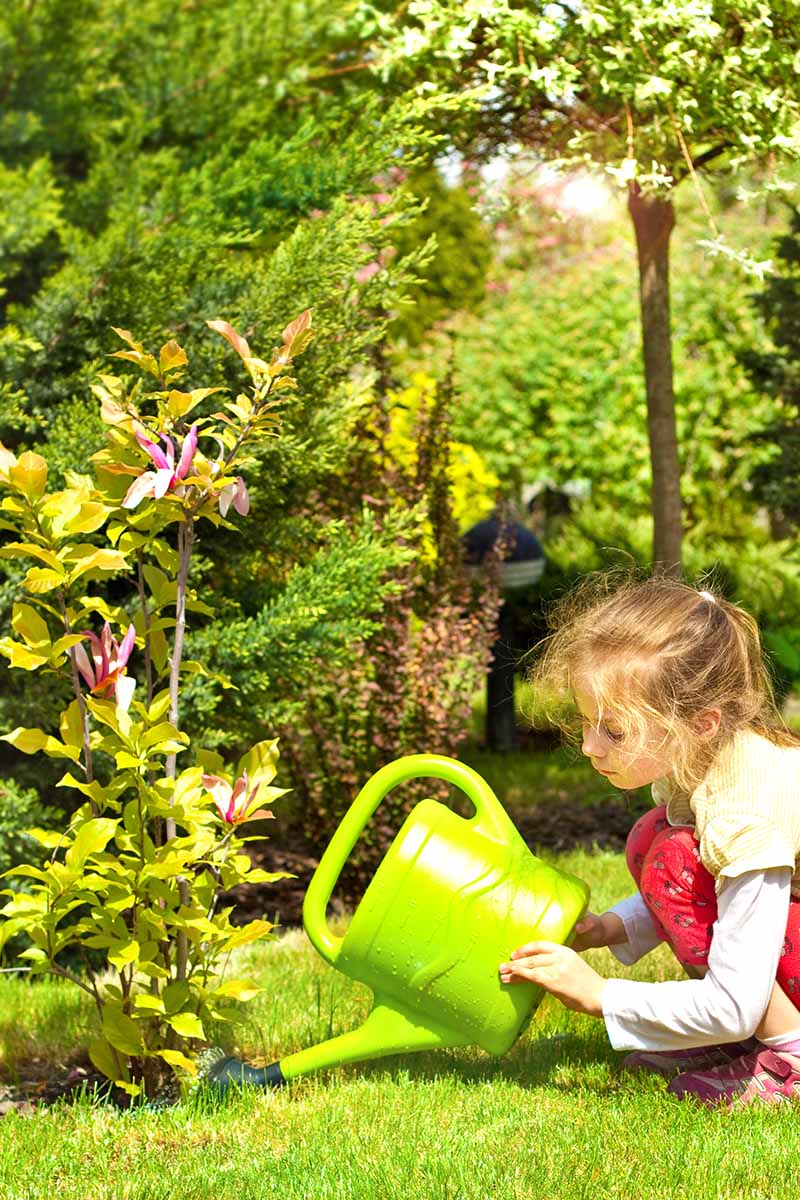
The blossoms are the tree’s way of reproducing, so when conditions are optimal, they’ll use their energy to produce flowers.
But in times of stress, the tree may need to put all its energy into survival instead of producing blooms.
Adequate water, especially in the fall, is vital. Depending on the species, the ground should be evenly moist at all times.
If nature isn’t providing enough water, get in there and irrigate your trees to keep the soil moist.
4. Fertilizer Problems
Too much nitrogen from overfertilizing is a problem for many reasons. For one, it’s causing serious problems in our water systems.
Second, it causes the accumulation of nitrates in the vegetative tissue. But in relation to your magnolia, it results in excessive leaf growth at the expense of flowering.
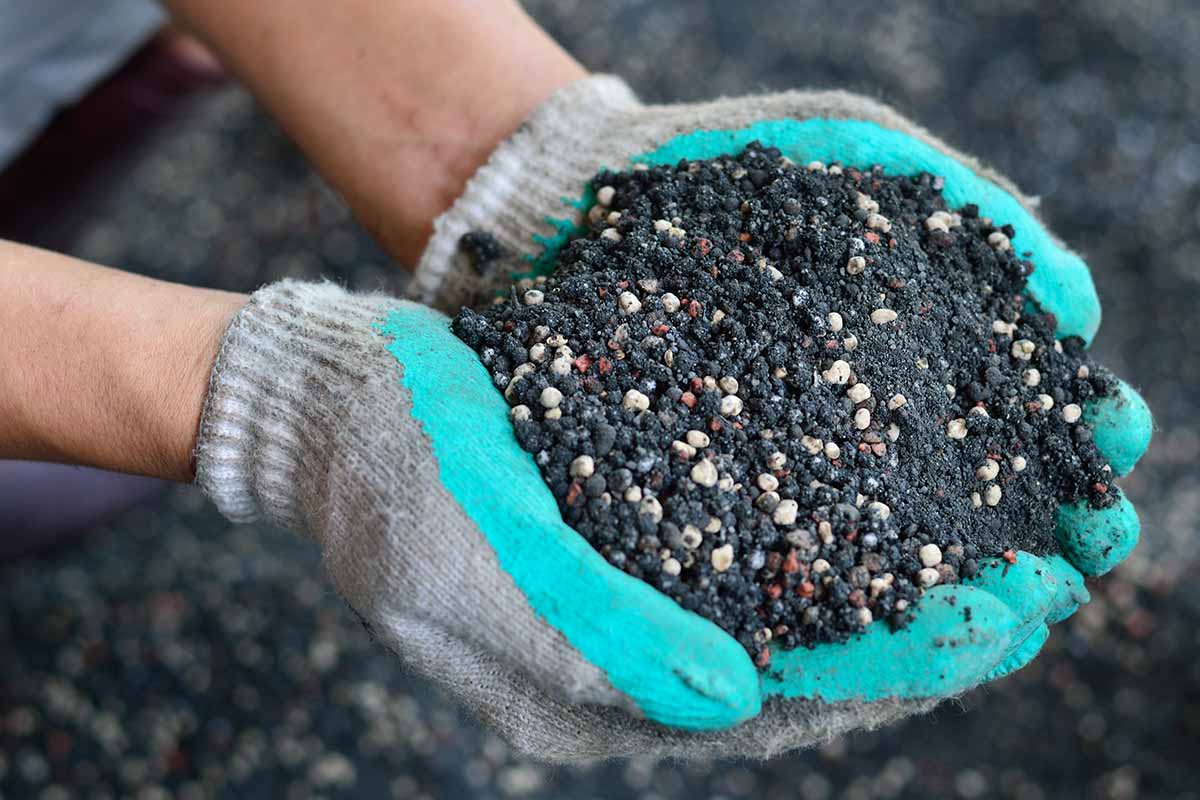
You should always test your soil in the spring, or in the fall after most of your plants die back for the year.
Gardeners often waste so much fertilizer feeding when the soil is already full of the nutrients we are adding.
Testing the soil is smart and affordable. You can buy a kit on Amazon for as much as a fast food dinner.
I use MySoil Soil Test Kit and am extremely happy with the details and the results. You can purchase your own kit via Amazon.

MySoil Soil Test Kit
You can also send in a sample to your local extension office for testing and by doing this, you’re supporting local growers as you can choose to share the results of your soil test for general knowledge. That’s the route I usually go.
Once you have the results of the test, amend your soil accordingly. You might find that you only need to add phosphorus and not nitrogen or potassium. Or maybe you won’t need to add any nutrients at all.
5. Pruning at the Wrong Time
Magnolias start developing their flower buds well in advance of their actual bloom time, usually in the early fall. So if you prune the trees in the fall, you end up cutting out the developing buds.

This is the easiest issue to prevent, simply do your pruning in the spring or summer, after flowering. Fortunately, most species don’t need much pruning to maintain a nice shape.
In general, I advise not to prune magnolias at all unless absolutely necessary.
These aren’t trees that bounce back readily from a pruning, and I’ve known more than one that never recovered.
Leave them alone unless pruning is needed to remove diseased, damaged, or deformed branches.
6. Stress
If the tree experiences stress during the previous growing season, it might not have the energy to produce flowers the next year. Those blossoms are an energy-intensive business.
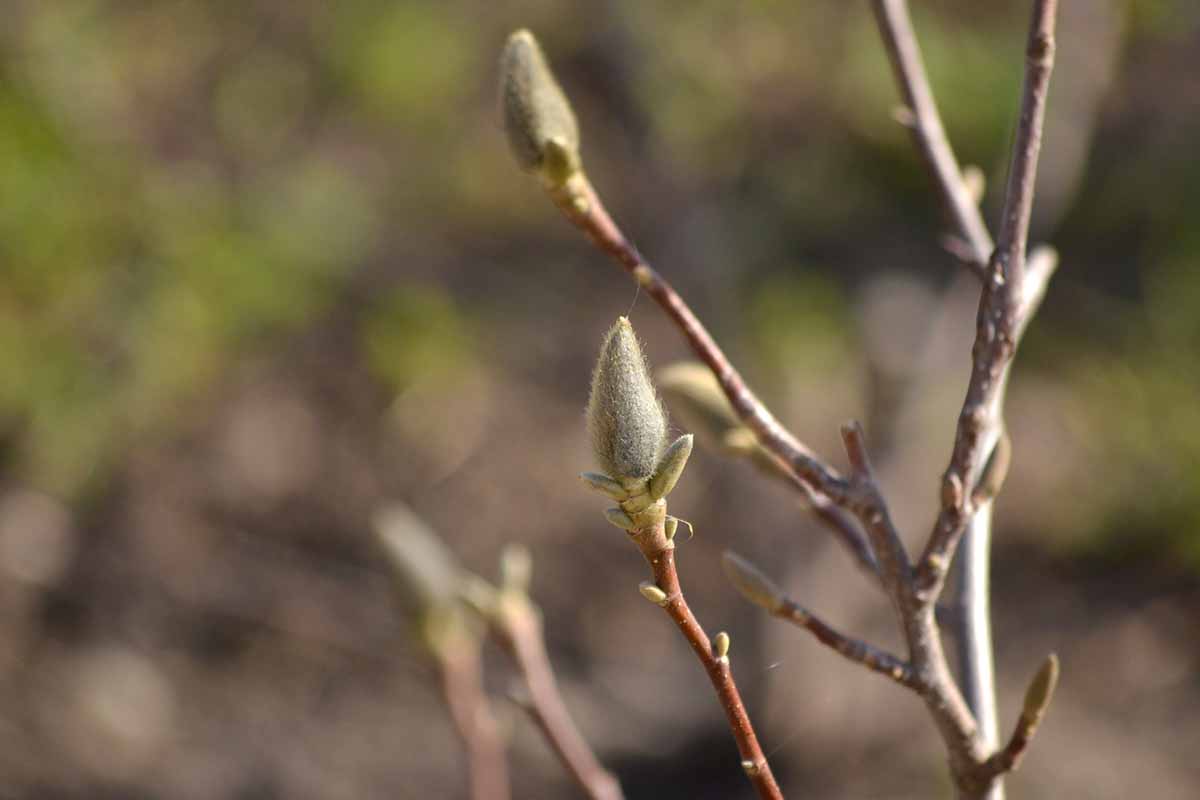
Prolonged flooding, pest infestation, or disease, particularly in the fall when the buds are developing, can result in fewer or no flowers.
To avoid this, do your best to support your tree with appropriate care, and watch closely for pests and disease so you can treat them before they stress the tree.
You can learn more about magnolia diseases in our guide.
7. Too Much Shade
Some species are happy in partial shade, while many need full sun to thrive and flower.
M. grandiflora, M. laeviflora, and M. stellata can all grow in part shade. There are also many cultivars that are bred to handle some shade. But generally, these trees do best in full sun.
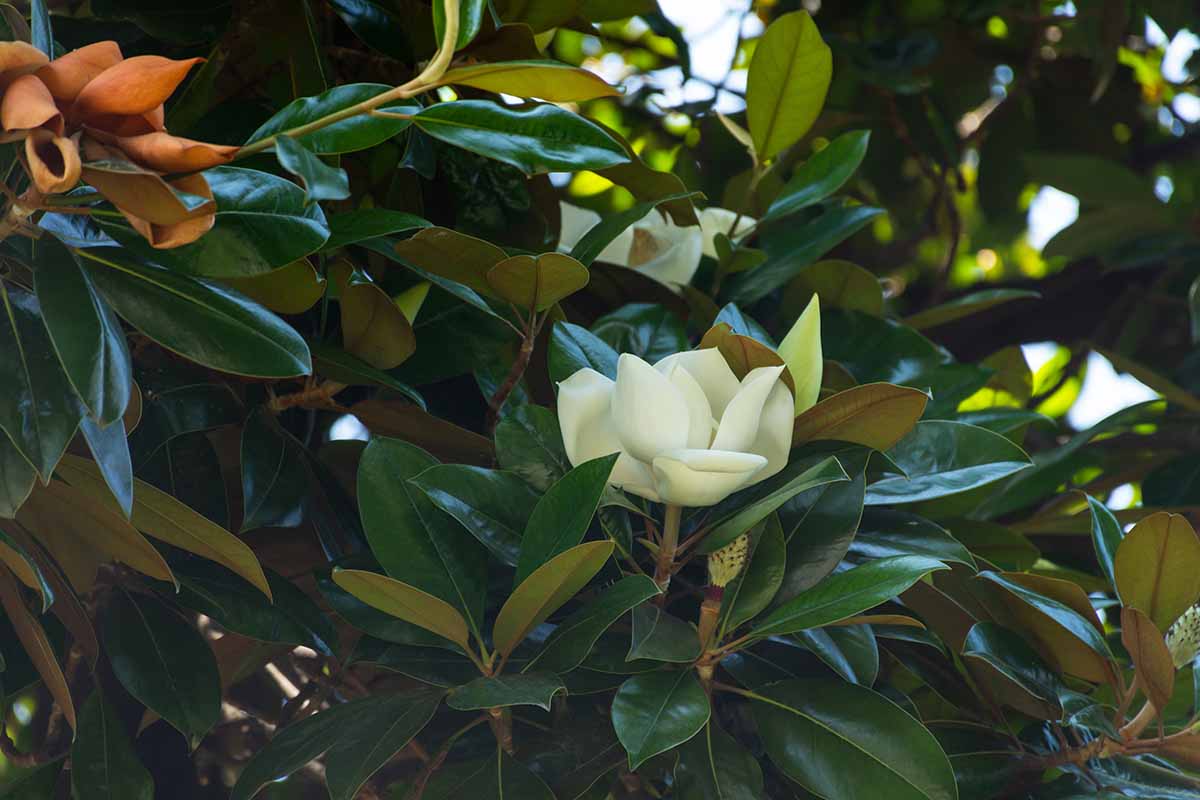
This can be tricky because most species tolerate some shade when they’re young, but they need full sun as they mature.
That makes sense when you picture their natural environment. Young plants start in the understory of the forest and then grow larger than everything around them, taking up all the sun.
So if we plant magnolias in some shade because they’re happy there when young, but they mature, the trees are then denied the sun they require.
When a magnolia is in too much shade, it won’t bloom.
On a cloudless day, observe your tree and determine how much direct sun it receives. If it isn’t receiving at least eight hours, a lack of sun could be causing the lack of flowers.
You can either plant a new tree in a better location, move your specimen, or prune nearby plants that are blocking sunlight.
Don’t Miss Out on the Performance
I have literally sat and watched my magnolia trees and the weather forecast with bated breath to see if the two will match up.
Will I see blossoms this year? Will Old Man Winter ruin the show? It’s stressful! As much as I enjoy my trees during the summer and fall, it’s that spring display that makes them so special.

What’s going on with your magnolia? Were you able to figure out the cause from this guide? If you still have any questions, let us know in the comments and we’ll see if we can help.
If you’d like to discover more about magnolia trees, we have a few guides that you might enjoy reading next:


